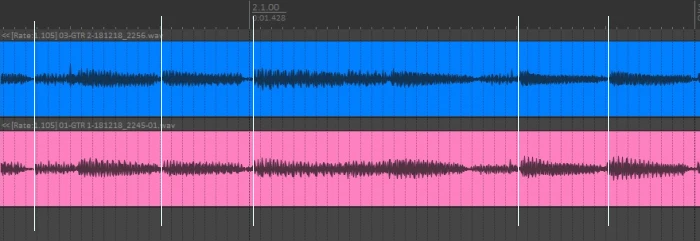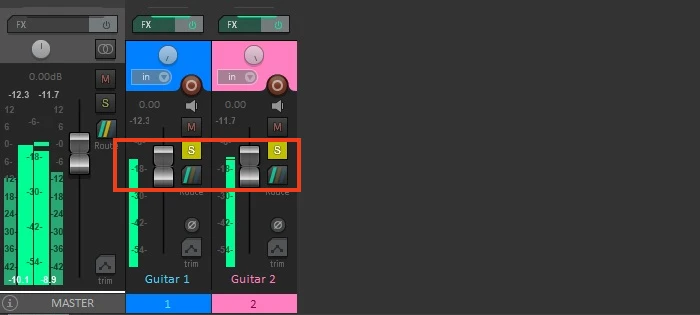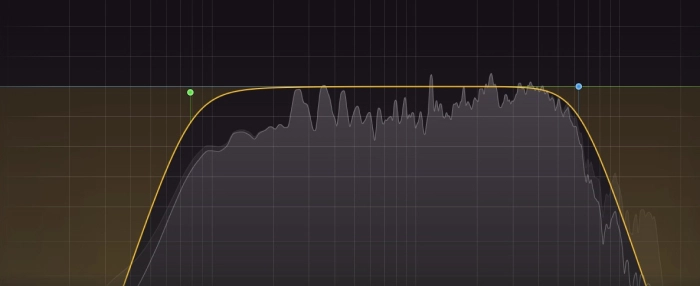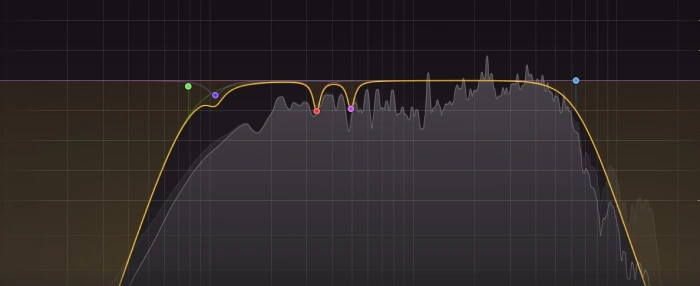The guitar is the most important instrument in metal and if you want to have a powerful guitar sound, you need to know how to mix heavy guitars.
In this step-by-step guide, you will learn how to create metal guitar tones and how to mix them. Follow these steps and your guitars will sound powerful, huge, and juicy.
It’s a great beginner’s guide to mixing metal guitars and creating a big and full sound that blasts the speakers.
How To Mix Metal Guitars
Creating great-sounding guitar mixes can be challenging. A good practice to have a huge guitar sound is to double-track the guitars.
Some people even go further and quad tracks their guitars. This will help to make guitars sound metal.
But the number of guitar tracks isn’t the point. Two guitar tracks are enough. The goal is to create good tones and then mix them together and that’s the most challenging task.
For this tutorial, I will use the double-track method. It means that I will record the same guitar part twice, with two different guitar tones.
Because a good guitar mix starts from tone and recording, this step is very important. After that, I will show you how mixing heavy guitars is done to create a wall of sound.
1. Create Good Metal Guitar Tones
The first step to mixing distorted guitars doesn’t concern mixing. It’s all about tone. You need to create a good guitar tone if you want to have a great-sounding mix.
Different music genres or even metal sub-genres need different guitar tones. For example, Metallica, Black Sabbath, and Slipknot are metal bands, but they have completely different guitar tones.

Also, you may create a heavy guitar tone you love, but for someone, it might be not as good and pleasing.
So, it’s subjective but there is an objective truth. You may not like the tone itself but if a guitar tone sounds good with other instruments, then it’s good.
To achieve the desired guitar tone for your song, it is essential to create a demo version of the track prior to recording. This will enable you to fine-tune and tailor the guitar sound to perfectly complement your song.
When you have a demo of your song, you look at it as a whole and understand what type of sound it needs.
So, create two guitar tones and use different guitars, amps, or settings for each sound. Two tones must have different sounds but must sound good together.
2. Record Tight Guitar Parts
After you create good guitar tones, the next step is to record them. And good playing and recording are crucial for great mixes.
You can’t mix distorted guitars properly if you don’t have a good and tight guitar recording.
You can record electric guitars in many different ways. You can use a real guitar amp, amp sim, guitar DI track, and so on. But the crucial thing is to play your guitar parts perfectly and make as few mistakes as you can.
And next, when you record your second guitar, it must be tight. Two guitars must sound like one. Bad timing or sloppy playing will cause many issues.
Actually, you won’t be able to create good guitar mixes if the recording is bad.

So, take your time, practice your guitar riffs, and play them perfectly while recording. It’s better to play the whole song from start to finish. If you make any minor mistake, you can fix it later.
After you finish the recording of both guitars, listen to it. If it sounds like one guitar, that’s great but if you hear some sloppy parts, bad timing, or something similar, try to record again.
A good guitar tone and tight recording is the key to great guitar mixes.
3. Level Match and Panning
Now it’s time to mix heavy guitars for real. And it starts with matching the volume levels and guitar panning.
The volume level matching creates a balance between guitars. On the other hand, panning creates width and fills the whole mix. Both together create a wall of guitar sound.
Because it’s two different guitars recorded separately, their volume won’t be exactly the same. So, it’s better to balance them and match the volume level.
Use guitar track faders for level matching. Set the first guitar volume at the point where you like it and match the second guitar volume.
For example, if the first guitar RMS is -6dB, set the second guitar at the same level.

Also, it’s important to leave the headroom for your guitars. A good headroom practice for guitar RMS is -8dB, or something close.
Also, make sure your guitar tracks or master bust aren’t clipping. Give your guitars breathing space.
Once you’ve matched the levels of your guitars, widen the sound by panning them to the left and right.
In modern metal music or other heavy genres, a good practice is hard panning which means when you pan your guitars 100% left and right.

This panning technique helps guitars to fill the space. Also, it expands the sound and creates a stereo image.
Some people don’t hard-pan their guitars and use the 70% or 75% panning method. But hard panning is the best method for modern metal.
Don’t matter how you do it, the main goal is to balance your guitar volume and pan them to create a huge guitar sound.
4. Add Low Pass and High Pass Filters
Now you have two guitar tracks. Both have the same level and are panned on both sides. It’s time to apply HPF and LPF with EQ to remove unnecessary very low and high frequencies.
You can use any EQ plugin you like when mixing metal guitars. The goal is to clean up guitar sound and remove frequencies it doesn’t need. And you apply a filter on both guitars separately.
EQ settings will be slightly different for each guitar because they have different tones. You want to remove very low frequencies that create muddy sounds and very high, harsh frequencies.

In general, for heavy guitars, you can cut low frequencies below 150Hz and very high frequencies above 8 or 10kHz.
But depending on your guitar tones, it will be different. Use it as a general rule.
Just create an HPF and drag it until you hear the drastic change in sound. The guitar still needs some low frequencies. So don’t cut a huge portion of low-end. Just listen and stop where you don’t hear muddy frequencies anymore.
The same goes for a low-pass filter. Apply LPF and drag it until you don’t hear very harsh frequencies. The goal is to remove unnecessary high frequencies. Also, it will leave space for other instruments such as cymbals.
You don’t need any other EQ tweaks now. Just apply EQ filters to both guitars to remove unpleasant frequencies and clean your guitar sound.
5. Create Guitar Bus Track
In order to mix metal guitars, now you need to merge the two guitar tracks and mix that way. When you have good guitar tones that sound well together, there is no point to mix them separately.
And to merge two guitars, you need a guitar bus track. Create a new track and send both guitar signals to that track. Now you have a guitar bus track.

This means that both guitar signal goes to the guitar bus track and from there, it goes to the master bus. It’s great practice to merge different sounds together and mix them that way.
You don’t need to do anything. Volume levels and panning will be the same and the only difference is that you have both guitars in one track and you can mix it now.
6. Add HPF and LPF
At this stage, you have two guitar tracks, with HPF and LPF applied that go to a guitar bus track. It’s time to mix metal guitars with EQ. And mixing starts with high-pass and low-pass filters.
You have already done it on individual tracks. And now you want to do it on the guitar bus track.
This time removing low and high frequencies should be minimalistic because a good amount of frequencies are already removed.
But because now you have two guitars together on one track, there will be frequency build-up in low and high ranges.
As you did on individual tracks, add EQ to the track and apply LPF and HPF. Remove unnecessary frequencies to remove additional muddy and harsh frequencies. It will make the sound cleaner.
7. Cut and Boost Frequencies
After low cut and high cut, it’s time to do the main EQ changes. The first is to give breathing space to guitars by reducing certain frequencies. And secondly, boosting good, juicy frequencies to enhance guitar tone.
Because every guitar tone differed from the other, EQ settings will be different in every case.
But there is a way to find bad or good frequencies and adjust them. Let’s start by cutting bad frequencies.
Create an EQ band, make it narrow, and increase the volume. Now drag that bend across the frequency range and find the frequency that sounds bad. When you find a frequency that sounds bad, cut it.

In general, when you cut frequencies, the EQ band should be narrow and don’t cut too much. A few decibels will be enough. But everything depends on the guitar tone and personal preferences.
In heavy guitars, muddy and boxy sound comes from 350-600Hz. So, listen to that frequency range and cut the ones that sound bad.

Do the same with boosting. Create a point on the frequency range, a little bit wider, find the frequencies that sound good, and boost them.
Boost by a couple of decibels and make the EQ band wider. In general, when you cut frequency, the EQ band should be narrow. But when you boost it, make it wider.

A good frequency of metal guitar tones is in the range of 1 and 3kHz. Try to find where it sounds the best and boost it. Some frequencies could sound harsh in this section and you need to cut them.
The goal of heavy guitar mixing is to cut unpleasant frequencies and make the guitar tone cleaner. At the same time, find good-sounding frequencies and enhance them by boosting.
If you have trouble finding the right frequencies, you can check the metal guitar EQ cheat sheet.
8. Use Dynamic EQ With Palm Muting Parts
Distorted guitars don’t require compression. Distortion or overdrive sound is already compressed but because palm muting causes low-frequency build-up around 100-250Hz, you may want to compress it.
But there is a better way and that’s the dynamic EQ. It allows you to cut frequency if the sound crosses the threshold, or use another instrument signal to cut it. You may use this method every time you mix metal guitars.
Let’s say you are satisfied with your guitar mix. It sounds great and sits well in the mix. But when the palm muting part comes, there are some issues with the sound. Or it might interfere with the kick drum or bass.
This is what you need to do. Apply dynamic EQ and cut the frequency where palm muting causes low-frequency accumulation. Then set the threshold.

So, that frequency will be cut only then when the sound will exceed the threshold.
That way you can control your palm muting parts and cut the frequency only when you play the palm muting parts.
Alternatively, you can use another instrument as a trigger. For example, instead of a threshold, you can set a kick drum or bass guitar as a trigger.
So, when the palm-muting part comes, a kick drum or bass guitar act as a trigger and cuts that frequency. There will be no muddy sound and you will hear each instrument clearly.
This is a great and very common technique when engineers mix metal guitars. Gives you more control over your sound.
9. Match Input and Output Volume
And the last step when you mix heavy guitars is to match the input and output signal of the guitar.
It’s critical for mixing metal guitars or any other instrument and track because when you cut or boost frequencies, it has an impact on the output signal.
Let’s say, you cut some frequency by 2dB. If your input volume was -6dB, now the output will be -8dB. Cutting lowers output volume and boosting increases it.
Input and output volumes must be the same and you can do it with gain control. Every EQ plugin has it. Some plugins call it a makeup gain, output gain or simply gain.

After you finish the mixing, check the volumes of input and output signals. And with the gain control make sure that the output volume is the same as the input volume.
It’s not for only guitars. Every instrument needs to have equal input and output signals. This is the rule not only for EQ but compressors too.
Conclusion
This is how you mix heavy guitars. Each step is very important and adds something to the final sound. You need to understand what each step does and how they work. Try to implement it in your work by creating a demo song and starting to tweak it.
Of course, there are countless methods for metal guitar mixing. Every distorted guitar sounds unique and may require a different approach. Also, every song differs from the other. This is just one method you can use and try if it works for you.
